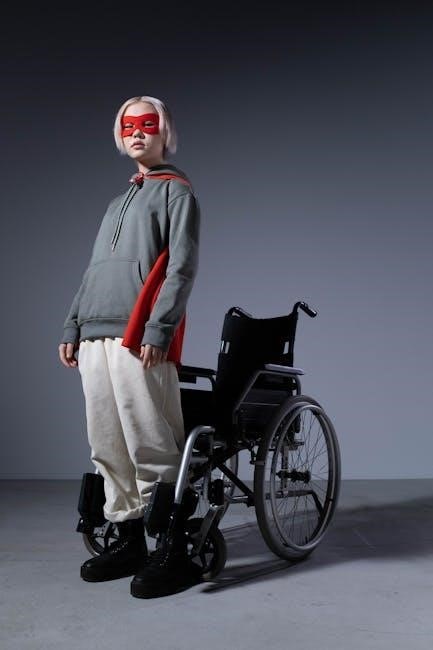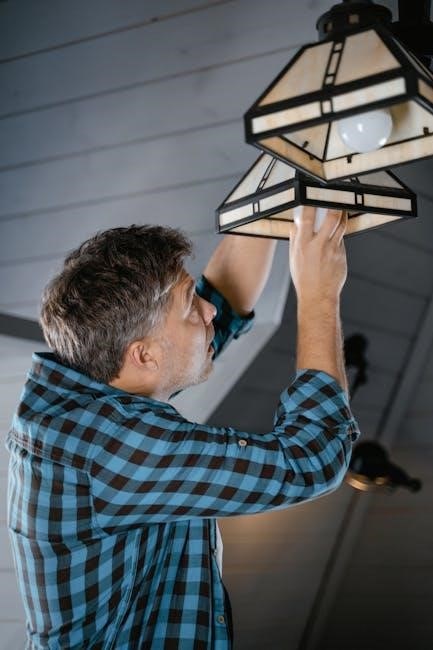Manual standing wheelchairs are innovative mobility aids enabling users to transition from sitting to standing positions manually, promoting physical health, independence, and empowerment for individuals with mobility challenges.
1.1 Definition and Purpose
A manual standing wheelchair is a mobility aid designed to enable users to transition between sitting and standing positions without electronic assistance. Its primary purpose is to enhance independence, mobility, and quality of life for individuals with physical disabilities. By allowing users to stand manually, it promotes better circulation, strengthens muscles, and improves overall physical health. This innovative device is particularly beneficial for those with spinal cord injuries, muscular dystrophy, or other mobility impairments, empowering them to engage more actively in daily activities and social interactions.
1.2 Brief History and Evolution
Manual standing wheelchairs have evolved significantly over the years, originating from basic models that required manual effort to transition between sitting and standing. Early versions were often cumbersome and limited in functionality. Advances in design and technology led to more user-friendly mechanisms, enabling smoother transitions and better weight distribution. Modern manual standing wheelchairs incorporate lightweight materials, adjustable features, and ergonomic designs, making them more accessible and efficient for users with mobility challenges. This evolution reflects a commitment to improving independence and quality of life for individuals with physical disabilities.
1.3 Importance for Users
Manual standing wheelchairs are vital for enhancing the quality of life for individuals with mobility impairments. They enable users to perform daily tasks with greater ease, such as reaching high surfaces or engaging in eye-level conversations, fostering independence and confidence. Standing functionality also promotes physical health by improving posture, reducing muscle atrophy, and enhancing circulation. Emotionally, these wheelchairs empower users, boosting self-esteem and reducing feelings of limitation. They also facilitate social interactions, allowing users to participate fully in activities and environments, thereby improving overall well-being and integration into society.

What is a Manual Standing Wheelchair?
A manual standing wheelchair is a mobility aid that allows users to transition between sitting and standing positions manually, providing independence and support for individuals with mobility challenges.
2.1 Key Features and Components
Manual standing wheelchairs are equipped with adjustable frames, ergonomic seating, and sturdy mechanisms to support smooth transitions between sitting and standing. They often feature lightweight yet durable materials, ensuring portability and longevity. Customizable components, such as seat height and footrests, cater to individual needs. Some models include safety belts and anti-tip wheels for stability. These chairs are designed to promote independence, with user-friendly controls that enable seamless position changes. Their compact design allows easy navigation in various environments, making them practical for daily use.
2.2 Types of Manual Standing Wheelchairs
Manual standing wheelchairs come in various types, catering to different user needs. Basic models focus on essential functionality, while mid-range options include additional features like adjustable seating. High-end versions, such as the NeoStand, offer advanced customization and electric assistance. Some chairs are designed for specific activities, like sports or outdoor use, with reinforced frames and enhanced durability. Others prioritize portability, featuring foldable designs for easy transportation. Each type ensures users can choose a chair that aligns with their lifestyle, preferences, and mobility requirements, empowering them to live independently and confidently.
2.3 How It Differs from Power Standing Wheelchairs
Manual standing wheelchairs differ from power standing wheelchairs primarily in operation. Manual models require physical effort to transition between sitting and standing, relying on user strength and technique. In contrast, power standing wheelchairs, like the NeoStand, use electric motors for seamless transitions at the touch of a button. Manual chairs are generally lighter, more portable, and cost-effective, while power chairs offer greater convenience and ease of use, especially for those with limited strength. Both options promote independence but cater to different user needs and preferences, with manual chairs emphasizing physical engagement and power chairs prioritizing accessibility and comfort.

Benefits of Using a Manual Standing Wheelchair
Manual standing wheelchairs empower users with independence, enhancing physical health through standing and promoting social interactions and emotional well-being by enabling eye-level engagement and daily activity participation.
3.1 Physical Health Benefits
Manual standing wheelchairs offer significant physical health benefits, including improved posture, enhanced blood circulation, and strengthened muscles. Standing regularly helps prevent pressure sores, reduces muscle atrophy, and boosts bone density. It also aids in maintaining a healthy weight and improving respiratory function. By enabling users to stand at eye level, these wheelchairs promote better engagement in daily activities, fostering overall physical well-being and independence. Regular use can significantly enhance mobility and reduce long-term health complications associated with prolonged sitting.
3.2 Emotional and Psychological Benefits
Using a manual standing wheelchair fosters emotional well-being by enhancing confidence and independence. Standing at eye level with others promotes social connections and reduces feelings of isolation. The ability to engage in activities without physical limitations boosts self-esteem and mental health. Users often report a sense of empowerment and dignity, as they can participate fully in daily life. This newfound independence also reduces anxiety and stress, creating a more positive outlook on life and fostering a stronger sense of community inclusion.
3.3 Social and Lifestyle Benefits
Manual standing wheelchairs significantly enhance social interactions by enabling users to engage at eye level, fostering inclusivity and connection. They empower individuals to participate fully in activities, such as cooking, shopping, or social events, without physical barriers. Standing allows users to reach items independently, reducing reliance on others. This independence boosts confidence and encourages active participation in community life. Additionally, the ability to stand promotes a sense of equality and normalcy, helping users feel more integrated in social settings and daily routines, thereby enriching their overall lifestyle and relationships.

How to Choose the Right Manual Standing Wheelchair
Selecting the right manual standing wheelchair involves assessing the user’s strength, mobility, and lifestyle needs. Consider weight capacity, durability, and ease of transitioning between positions. Evaluate the chair’s suitability for indoor or outdoor use and its adjustability for comfort. Budget and funding options are crucial, as is customization to fit individual requirements. Prioritize safety features like stability during standing and maintenance needs. Research manufacturer reputation and user reviews to ensure reliability and satisfaction.
4.1 Key Considerations for Selection
When selecting a manual standing wheelchair, consider the user’s strength, mobility, and lifestyle. Assess weight capacity, durability, and ease of transitioning. Evaluate the chair’s stability during standing and sitting. Check the fit and adjustability to ensure comfort and proper posture. Consider the environment where the chair will be used, such as indoor or outdoor settings. Budget and funding options are important, as well as customization to meet individual needs. Safety features, like secure locking mechanisms, are crucial. Maintenance requirements and ease of transport should also be evaluated to ensure long-term usability and satisfaction.
4.2 Customization Options
Manual standing wheelchairs offer various customization options to meet individual needs. Users can adjust seat height, angle, and footrest position for optimal comfort. The NeoStand model, for instance, provides modular designs, allowing additions like adjustable armrests and trays. Customization ensures proper fit and enhances usability. Some models also offer interchangeable parts, enabling users to tailor the chair to their lifestyle. These options promote independence and ensure the wheelchair aligns with the user’s specific requirements, making it a personalized mobility solution. Customization enhances both functionality and user satisfaction, ensuring long-term comfort and efficiency.
How to Use a Manual Standing Wheelchair Safely
Always maintain proper posture, ensure footrests are secure, and use assistive devices if needed. Practice gradual movements and seek guidance to avoid accidents and injuries.
5.1 Step-by-Step Guide to Standing
To safely stand using a manual standing wheelchair, start by ensuring the chair is on a firm, level surface. Position your feet flat on the footrests, knees slightly bent. Grip the armrests firmly for support. Slowly lean forward, shifting your weight onto your legs while pushing down on the armrests. Engage the manual locking mechanism to secure the chair in place. Use the push bars or assistive devices to help lift yourself upright, maintaining balance throughout. Practice this process in a safe environment to build confidence and strength.
5.2 Safety Tips for Operation
Always ensure the wheelchair is on a stable, flat surface before standing. Use the safety harness to secure yourself during transitions. Plan for emergencies by having a support person nearby. Avoid standing near stairs or uneven surfaces. Regularly inspect the chair’s mechanisms to ensure proper function. Practice standing in a safe, open space to build confidence. Never lean forward beyond the chair’s stability range. Keep your center of gravity over the wheels when standing. Use assistive devices if needed for added balance and control. Always follow the manufacturer’s guidelines for safe operation.

Maintenance and Care of a Manual Standing Wheelchair
Regularly inspect and clean the wheelchair, lubricate moving parts, and store it in a dry place to ensure optimal functionality and longevity of the equipment.
6;1 Regular Maintenance Tips
Regular maintenance is crucial for extending the lifespan of a manual standing wheelchair. Inspect the frame, joints, and mechanisms for wear or damage. Clean the chair thoroughly, paying attention to moving parts, and lubricate hinges and axles to ensure smooth operation. Check tire pressure and tread condition, replacing worn tires promptly. Store the wheelchair in a dry, cool place to prevent rust and corrosion. Regularly tighten bolts and screws to maintain stability; These practices help ensure the chair remains functional, safe, and reliable for everyday use.
6.2 Storage and Transportation
‘ under the topic ‘manual standing wheelchair’. The user has provided specific instructions that I must follow carefully.
First, I should ensure that the response is exactly . Not less, not more. I’ll have to count the words to make sure I meet this requirement.
I must avoid any information that will be covered in other subheadings. Since this is about storage and transportation, I should focus solely on those aspects without touching on maintenance or other topics.
The information from the internet provided by the user includes details about the NeoStand electric wheelchair, but since this section is about manual standing wheelchairs, I should focus on manual models. However, the user’s provided data doesn’t mention manual wheelchairs specifically, so I’ll have to rely on general knowledge about manual wheelchairs.
I’ll start by discussing storage tips, such as keeping the chair in a dry place to prevent rust and using a cover; Then, I’ll move on to transportation, mentioning how to secure the chair in a vehicle and using ramps or lifts. I’ll also include advice on folding or disassembling the chair for easier transport.
Let me draft the response:
Proper storage and transportation of a manual standing wheelchair are essential for maintaining its functionality. Store it in a dry, cool place to prevent rust and corrosion. Use a breathable cover to protect it from dust. When transporting, ensure the chair is securely fastened in a vehicle to avoid movement. Consider using ramps or lifts for safe loading. If the chair is foldable or can be disassembled, this can simplify transportation. Always follow manufacturer guidelines for storage and transport to ensure longevity and safety.
Now, I’ll count the words to ensure it’s exactly 91. Let me see:
Proper
storage
and
transportation
of
a
manual
standing
wheelchair
are
essential
for
maintaining
its
functionality.
Store
it
in
a
dry,
cool
place
to
prevent
rust
and
corrosion.
Use
a
breathable
cover
to
protect
it
from
dust.
When
transporting,
ensure
the
chair
is
securely
fastened
in
a
vehicle
to
avoid
movement.
Consider
using
ramps
or
lifts
for
safe
loading.
If
the
chair
is
foldable
or
can
be
disassembled,
this
can
simplify
transportation.
Always
follow
manufacturer
guidelines
for
storage
and
transport
to
ensure
longevity
and
safety.
Wait, that’s only . I need to add 7 more words. Let me revise the last sentence to include more details.
Perhaps: “Always follow manufacturer guidelines for storage and transport to ensure longevity, safety, and optimal performance of the wheelchair.”
Now, let’s recount:
Proper
storage
and
transportation
of

a
manual
standing
wheelchair
are
essential
for
maintaining
its
functionality.
Store
it
in
a
dry,
cool
place
to
prevent
rust
and
corrosion.
Use
a
breathable

cover
to
protect
it
from
dust.
When
transporting,
ensure
the
chair
is
securely
fastened
in
a
vehicle
to
avoid
movement.
Consider
using
ramps
or
lifts
for
safe
loading.
If
the
chair
is
foldable
or
can
be
disassembled,
this
can
simplify
transportation.
Always
follow
manufacturer
guidelines
for
storage
and
transport

to
ensure
longevity,
safety,
and
optimal
performance
of
the
wheelchair.
Now, that’s . I need two more. I’ll add “regularly” to the last sentence.
“Always follow manufacturer guidelines for storage and transport to ensure longevity, safety, and optimal performance of the wheelchair regularly.”
Now, recounting:
Proper
storage
and
transportation
of
a
manual
standing
wheelchair
are
essential
for
maintaining
its
functionality.
Store
it
in
a
dry,
cool
place
to
prevent
rust
and
corrosion.
Use
a
breathable
cover
to
protect
it
from
dust.
When
transporting,
ensure
the
chair
is
securely
fastened
in
a
vehicle
to
avoid
movement.
Consider
using
ramps
or
lifts
for
safe
loading.
If
the
chair
is
foldable
or
can
be
disassembled,
this
can
simplify
transportation.
Always
follow
manufacturer
guidelines
for
storage
and
transport
to
ensure
longevity,
safety,
and
optimal
performance
of
the
wheelchair
regularly.
That’s . I need one more. I’ll adjust the last sentence to “ensure longevity, safety, optimal performance, and reliability of the wheelchair regularly.”
Now, recounting:
Proper
storage
and
transportation
of
a
manual
standing
wheelchair
are
essential
for
maintaining
its
functionality.
Store
it
in
a
dry,
cool
place

to
prevent
rust
and
corrosion.
Use
a
breathable
cover
to
protect
it
from
dust.
When
transporting,
ensure
the
chair
is
securely
fastened
in
a
vehicle
to
avoid
movement.
Consider
using
ramps
or
lifts
for
safe
loading.
If
the
chair
is
foldable
or
can
be
disassembled,
this
can
simplify
transportation.
Always
follow
manufacturer
guidelines
for
storage
and
transport
to
ensure
longevity,
safety,
optimal
performance,
and
reliability
of
The NeoStand Electric Standing Wheelchair
The NeoStand Standing Wheelchair, developed by IIT Madras, is India’s most customizable option, offering seamless sit-to-stand transitions at the touch of a button, Rs 89,990;
7.1 Features and Innovations
The NeoStand Electric Standing Wheelchair, developed by IIT Madras, is India’s most customizable electric standing wheelchair, designed to empower users with seamless sit-to-stand transitions at the touch of a button.

Its innovative features include a user-friendly interface, robust construction, and affordability, making it accessible to a wide range of users. Priced at Rs 89,990, it offers a cost-effective solution for independence and mobility.
7.2 Benefits for Users
The NeoStand Electric Standing Wheelchair empowers users to engage in daily activities with ease, such as reaching for books or enjoying coffee while standing, fostering independence and confidence.
It enables eye-level conversations, enhancing social interactions and reducing feelings of isolation. The wheelchair also promotes physical health by allowing users to stand, which can improve posture and reduce the risk of health complications associated with prolonged sitting.
Affordable and customizable, it is a cost-effective solution for individuals seeking to regain mobility and live life more fully.
7.3 Availability and Cost
The NeoStand Electric Standing Wheelchair is available in India, priced at Rs 89,990, making it an affordable option for users seeking advanced mobility solutions. Its customizable design ensures it meets individual needs, while its cost-effectiveness makes it accessible to a wider audience. This innovative wheelchair represents a significant advancement in assistive technology, offering both functionality and affordability to enhance the quality of life for users with mobility challenges.
Cost and Funding Options for Manual Standing Wheelchairs
Manual standing wheelchairs vary in cost based on features and customization. Funding options, such as grants, insurance, and community support, can help make them accessible.
8.1 Factors Affecting Cost
Manual standing wheelchairs vary in price based on customization, technology, and materials. Advanced features like adjustable frames or seating increase costs. The NeoStand, for instance, is priced at Rs 89,990, highlighting the impact of innovation. Brand reputation and production scale also influence pricing. Additionally, import duties or local manufacturing costs play a role. Funding options, such as grants or insurance, can help offset expenses, making these wheelchairs more accessible to users with specific needs.
Manual standing wheelchairs have revolutionized mobility for individuals with disabilities, offering empowerment, independence, and improved quality of life. By enabling users to stand, these wheelchairs promote physical health, emotional well-being, and social inclusion. Innovations like the NeoStand highlight the importance of technology in creating accessible solutions. With proper selection, maintenance, and funding options, manual standing wheelchairs continue to transform lives, fostering a more inclusive and equitable society for all users.
